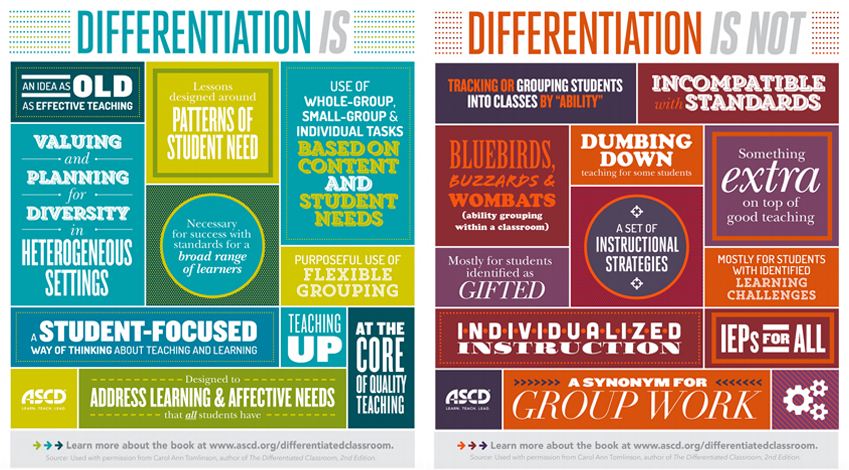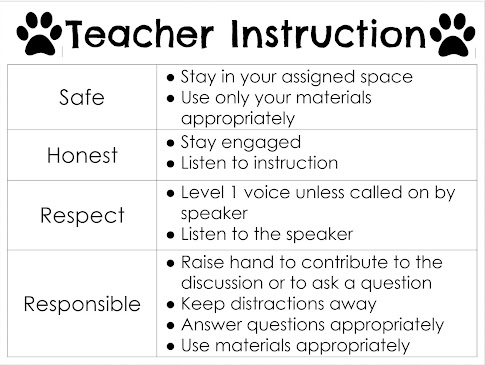Blog Post #11: Differentiation in a Classroom Setting
Chapter 1: What is Differentiation
What are the 4 key elements of differentiation instruction-- describe each element in your own words and why it is important.
The 4 key elements of differentiation instruction are rigor of instruction, relevancy of instruction and content, flexibility and variation of instruction, and the complexity level of instruction. Rigor looks at providing students with the right level of challenge while also ensuring that they feel successful. As a teacher, I don't want to give students work they can always get easily as it doesn't stretch their thinking or skills. By seeing where they are, I can give them work and instruction that will challenge them and help them develop more skills to propel their learning. As for relevancy, it's important to ensure that we are putting our focus on instruction and learning instead of giving students more things to work on or busy work activities. We want the work we give them to have a meaningful purpose that allows them to apply what they learned. When it comes to flexibility and variation in instruction this looks to allow the student to demonstrate their learning in a method that works best for them. This could be that students create a video, poster, or paper to show what they learned about a topic. Flexibility also helps to accommodate different learning styles in students. Flexibility can also be extended to allowing students to choose if they work on something independently, with a partner, or with a small group. This allows students to work with structured support if they choose. Complexity looks to go deeper with content and concepts rather than skimming the surface. This looks to actively engage students to think deeper and ask questions about the content.
What are the two primary "roles" of a teacher when differentiating instruction?
When differentiating instruction, teachers take on the roles of a facilitator and a collaborator. As a facilitator, teachers have three key responsibilities: providing and prescribing differentiated learning opportunities, organizing students for learning, and using time flexibly. Being a facilitator looks at how we can give students what they need to learn best. This could be how we strategically give them a peer or group of peers they can work with or around to succeed. It could look like a teacher giving students different math problems to solve to ensure that they can understand the desired math skill. As a collaborator, this looks at working with other grade-level teachers, specialists, other staff members, as well as parents. It's important to gather resources from others as well as gain insight into what they are noticing about a student and their learning. With this information, we are better able to proceed in how to teach our students effectively.
Chapter 2: Who Are Your Students
What are the different ways teachers gather information about their students to inform how they differentiate their instructional methods?
The different ways that teachers gather information about their students to inform how they differentiate their instructional methods are looking at a student's academic history in their student portfolio, having students fill out an interest inventory or survey, using Howard Gardner's multiple intelligences model, involving families, and conducting multiple intelligence observations. By looking at a student's academic history, a teacher can see areas of strength and struggle. It allows us to see what interventions have been successful or not. With this information, a teacher can make decisions about how to best teach this student by meeting them where they are at. Having a student complete an interest inventory or survey helps a teacher to reach a student by letting their interests guide what we teach about and how we teach it. For example, if a student likes cars, I may include that in a guide reading level book or a math problem. If a student likes to draw, I may allow them to draw a picture that goes along with their learning as a form of note-taking and assessment of learning. By involving families, we get a full picture of the student as a whole. Teachers see them academically and families see them in all other aspects. By combining these two parts of a student, we are able to make decisions about how best to teach them.
Why is knowing your students important to creating unit objectives and lesson plans?
Knowing your students is important when creating unit objectives and lesson plans, because when we know them, we know how to give them instruction and work to help them succeed in their learning. Knowing their interests, learning styles, and intelligence levels, a teacher can plan instruction that will meet the needs the all. They may decide to do a whole group lesson and then break the class into small groups based on their learning levels or interests. It can aid in the kinds of assessments students are given to demonstrate learning. A teacher may know that some students enjoy writing whereas other students like hands-on projects so they decide that students can pick between writing a paper or creating a poster/diagram. This allows all students to choose the method that best suits their interests and learning styles. If we only plan according to standards and the curriculum, we lose authenticity in learning, and frankly, we lose our students as we aren't putting them at the forefront of the decision-making process when they are the ones who are impacted the most. Knowing our students means that we can create a true learning opportunity for all.
Part 2: Responses (Video)
What are the top 3 things you learned about differentiating instruction from the video?
One of the top 3 things I learned from the video is that before a teacher can differentiate successfully, they must accurately assess their student's competence level. Students may not get what they need to succeed or be challenged without accurate data. Throughout the year assessments should be used to allow for the differentiation to change as students' learning is ever-changing. Another top thing I learned from the video is the importance of scalding or tiering a lesson to better allow for student learning across a class that has students learning at different levels. The last top thing I learned from the video is the importance of using an exit to gauge student learning. Knowing where a student is at, better allows a teacher to see what extra scaffolding they may need to provide a student.
What does it mean to "differentiate" instruction?
To "differentiate" means that a teacher responds to the diverse learning needs of their students to ensure they all learn the key concepts. It also means that you cater to different learning levels and styles. It's about asking what is working and what is not and letting the answers lead the lesson-planning process. To "differentiate" instruction means teachers meet students where they are at, allowing them to feel successful in their learning.
What elements of lesson planning can you differentiate?
An element of lessening planning that a teacher can differentiate is the complexity of the language they are using with groups of students to help promote learning as well as challenge students who need it. Another way is to split instruction time where you do a whole group lesson and then group students by ability, learning style, and/or interests and have small group instruction. Another element of lesson planning that you can differentiate is exit tickets. Teachers can give students questions to answer that vary in complexity to ensure that students have the basic fundamental skills and/or learning they need from a lesson or unit.
Part 3: Evidence
How have you seen evidence of differentiated instruction in your classroom? (3 examples)






Comments
Post a Comment